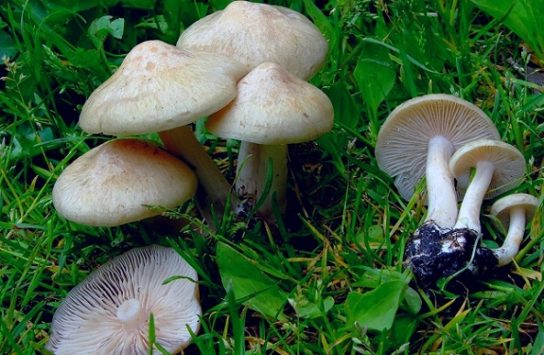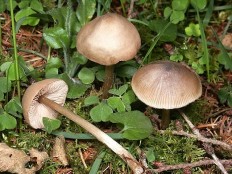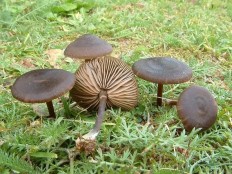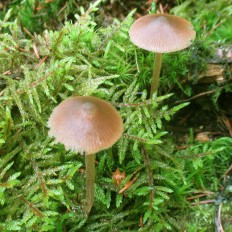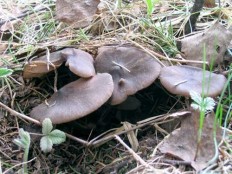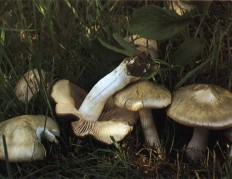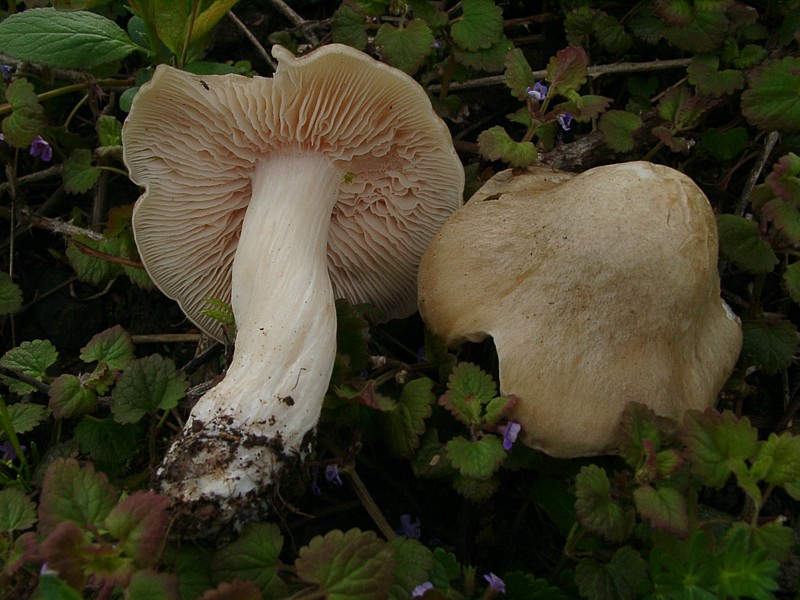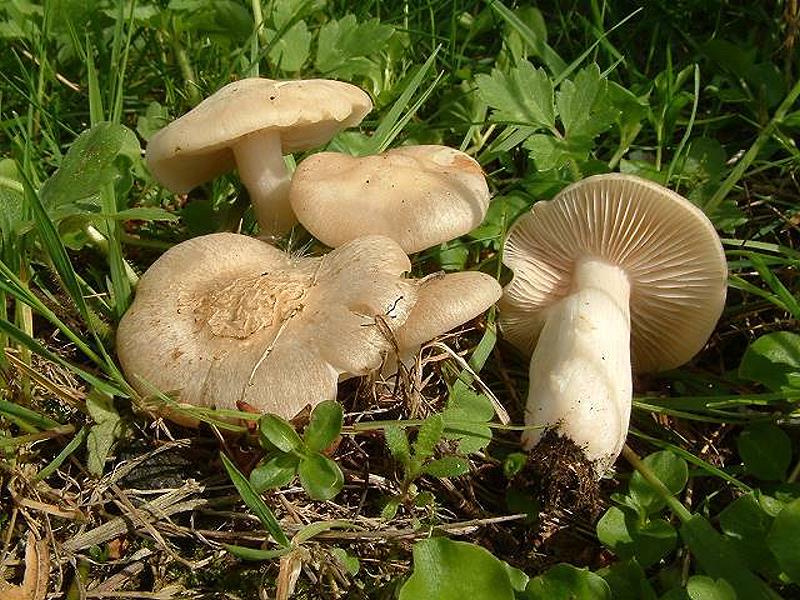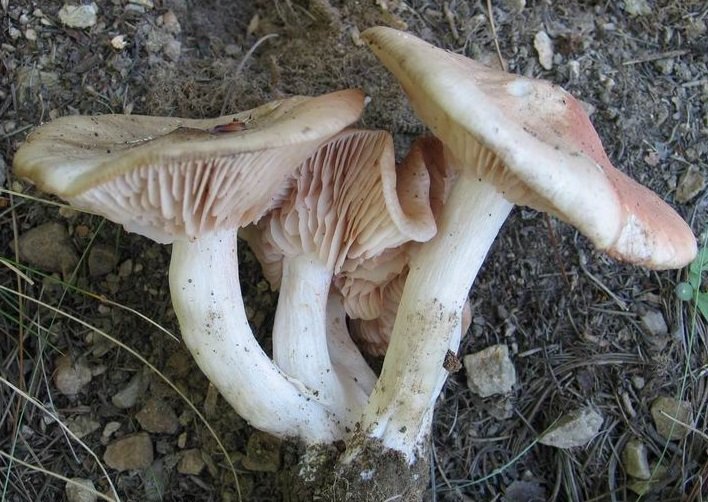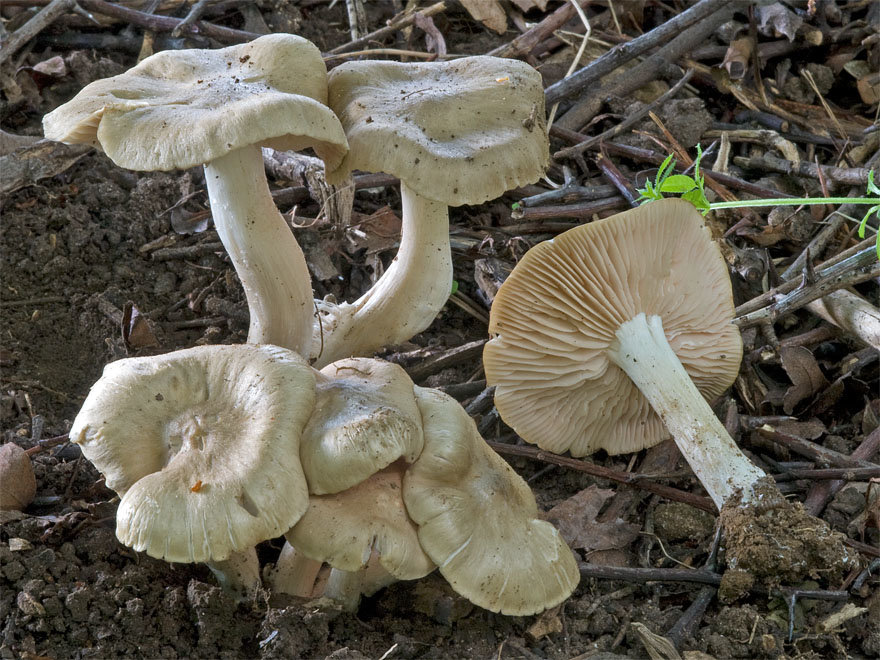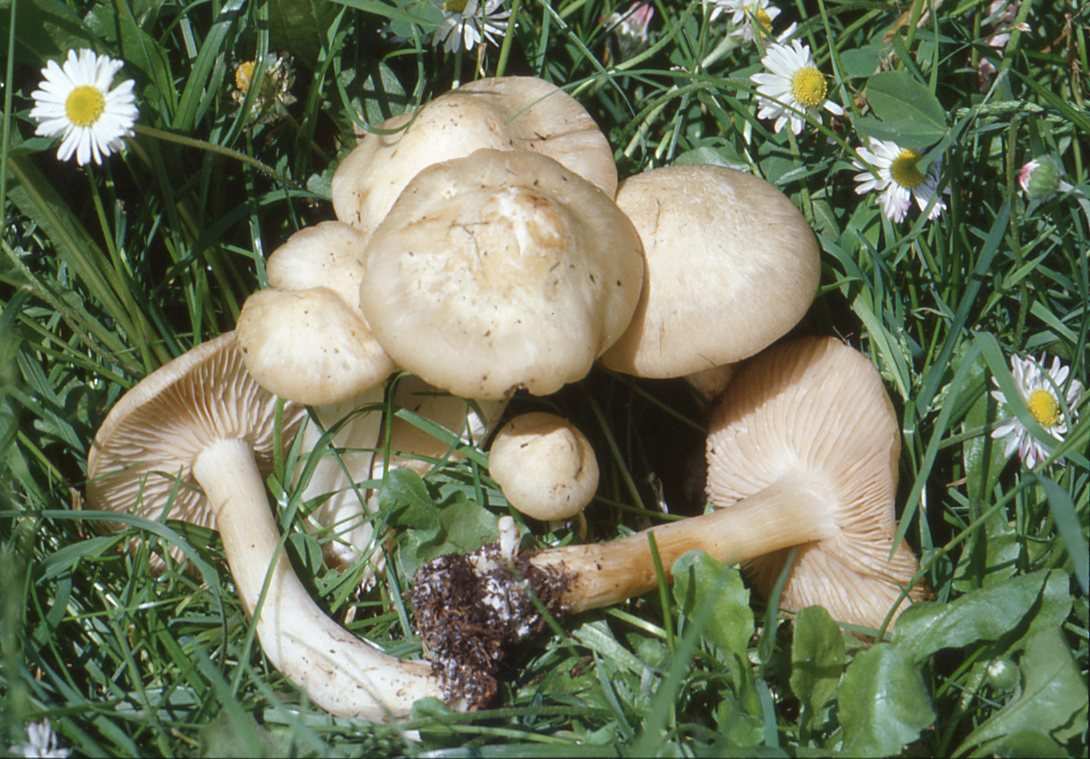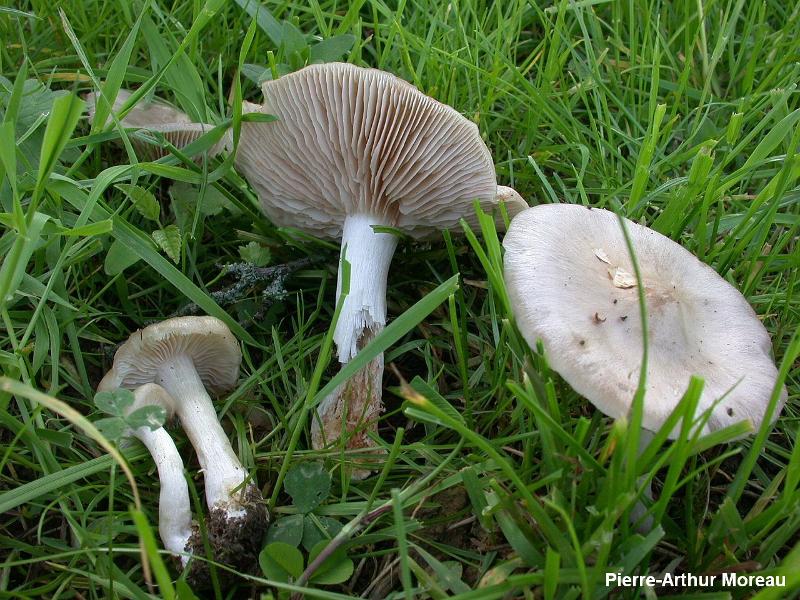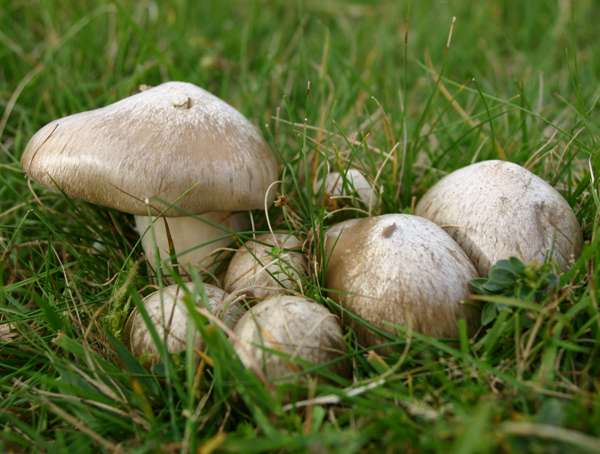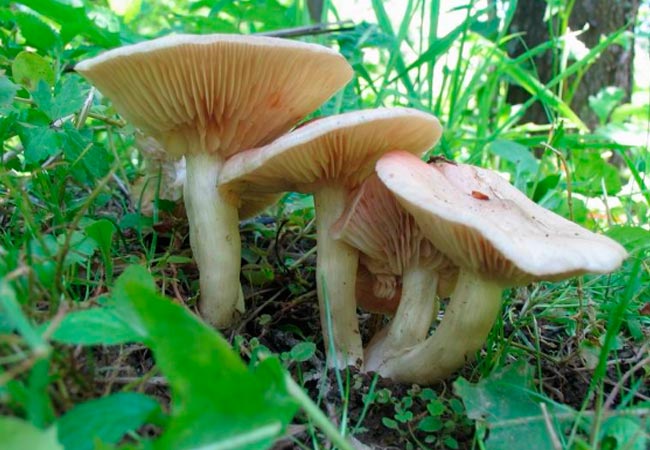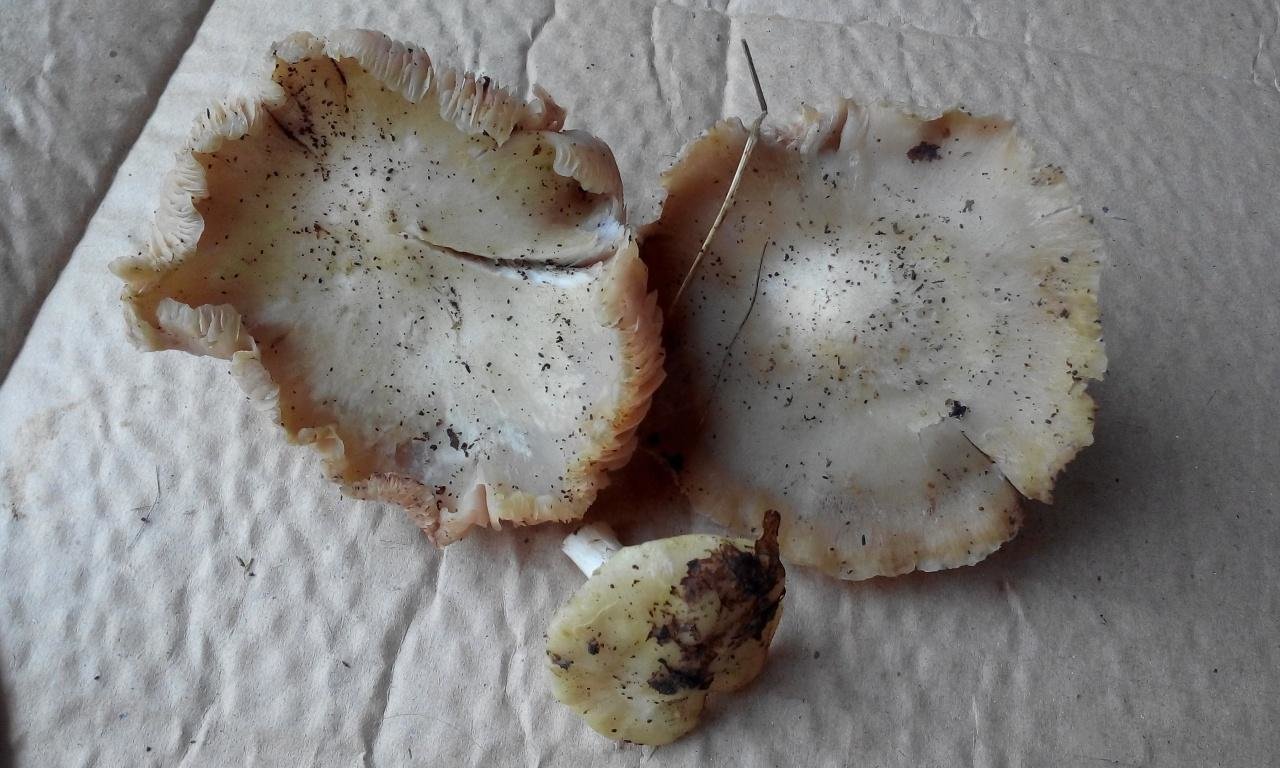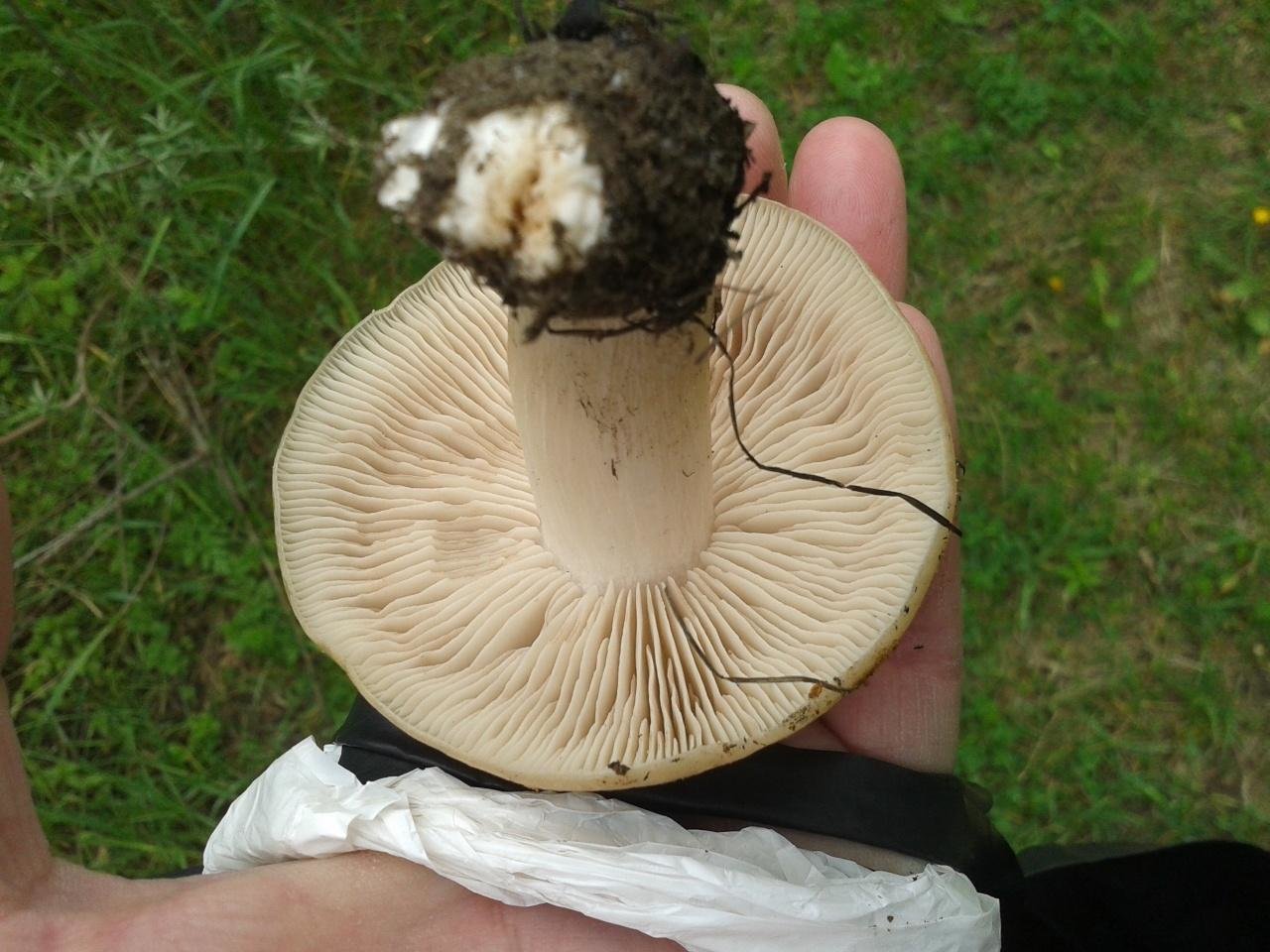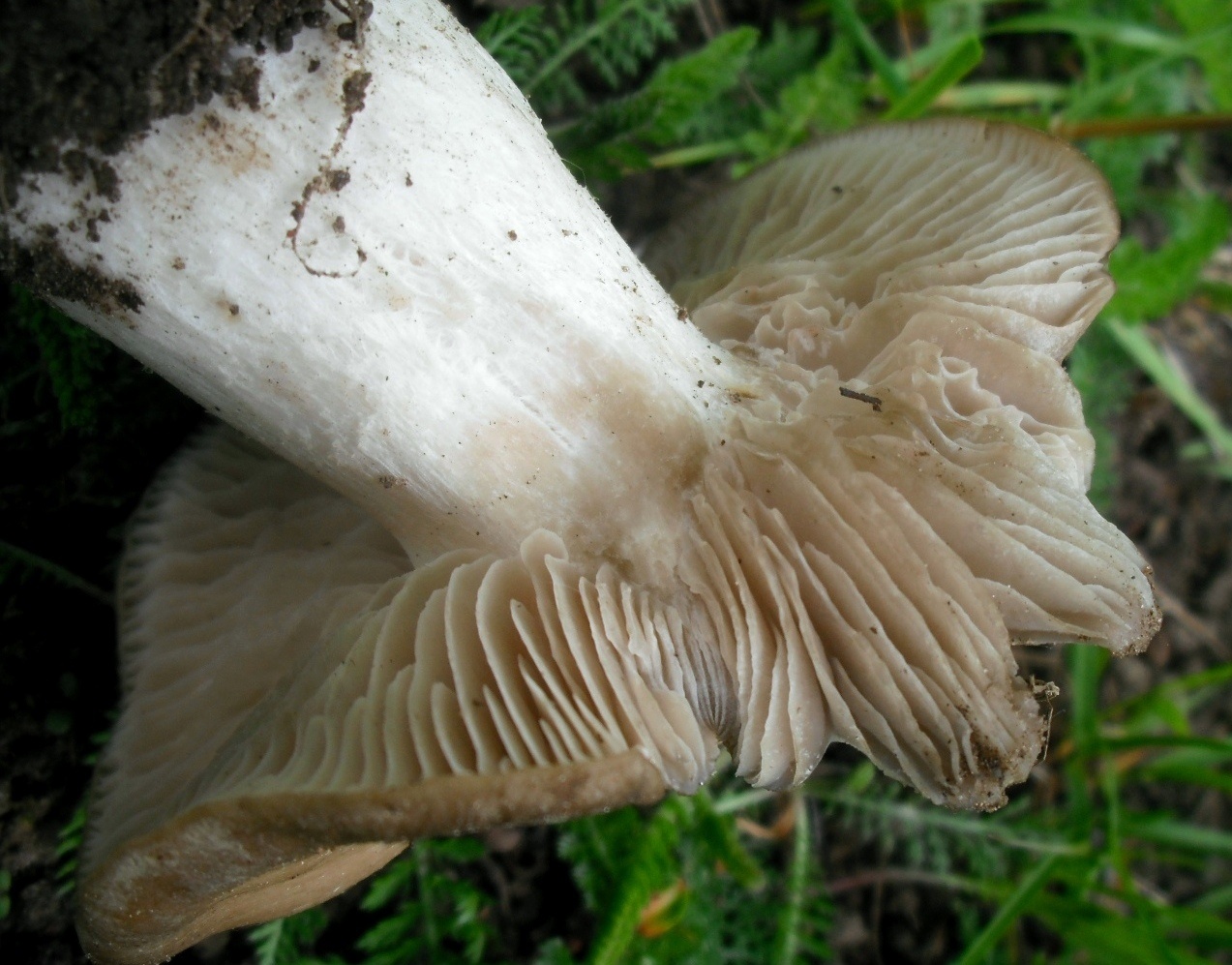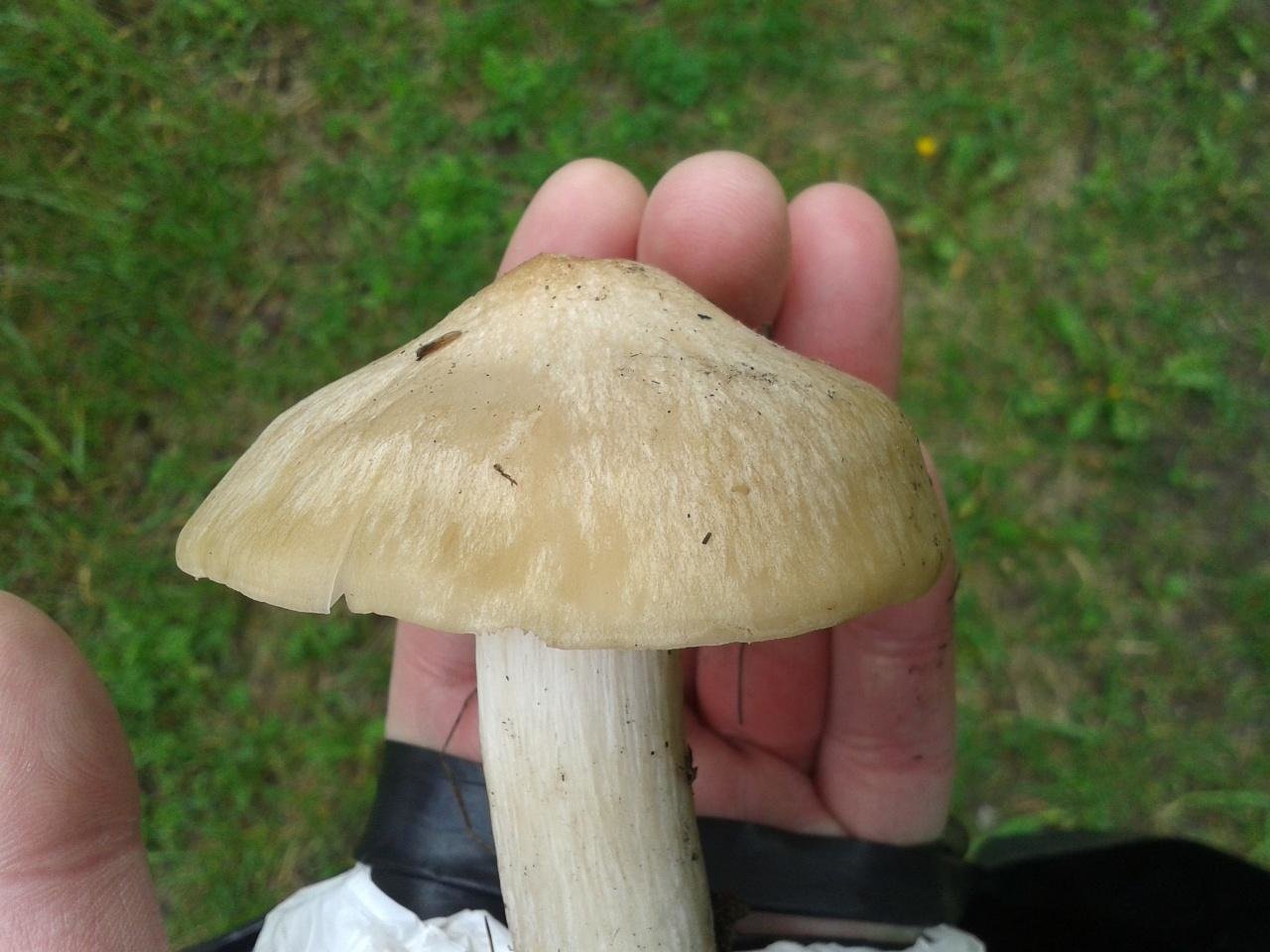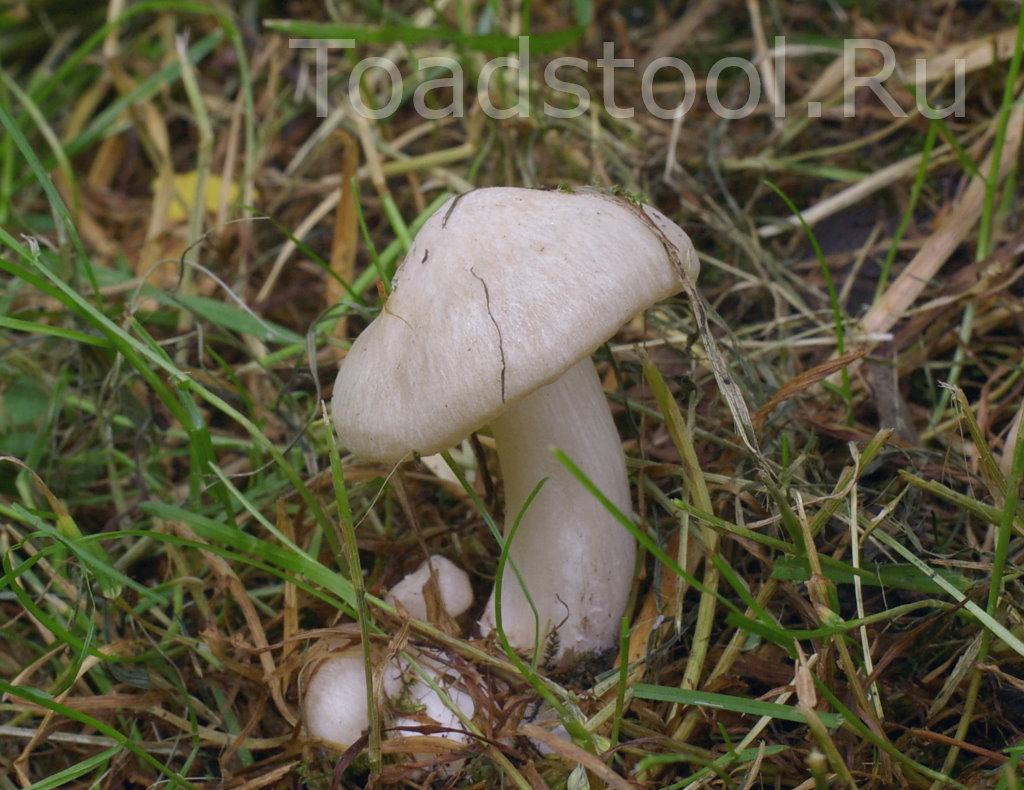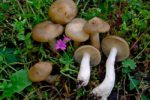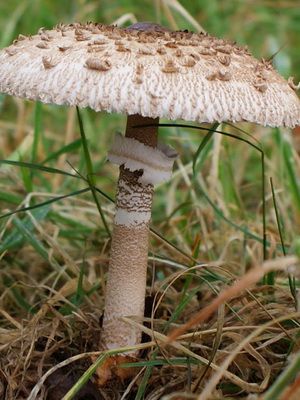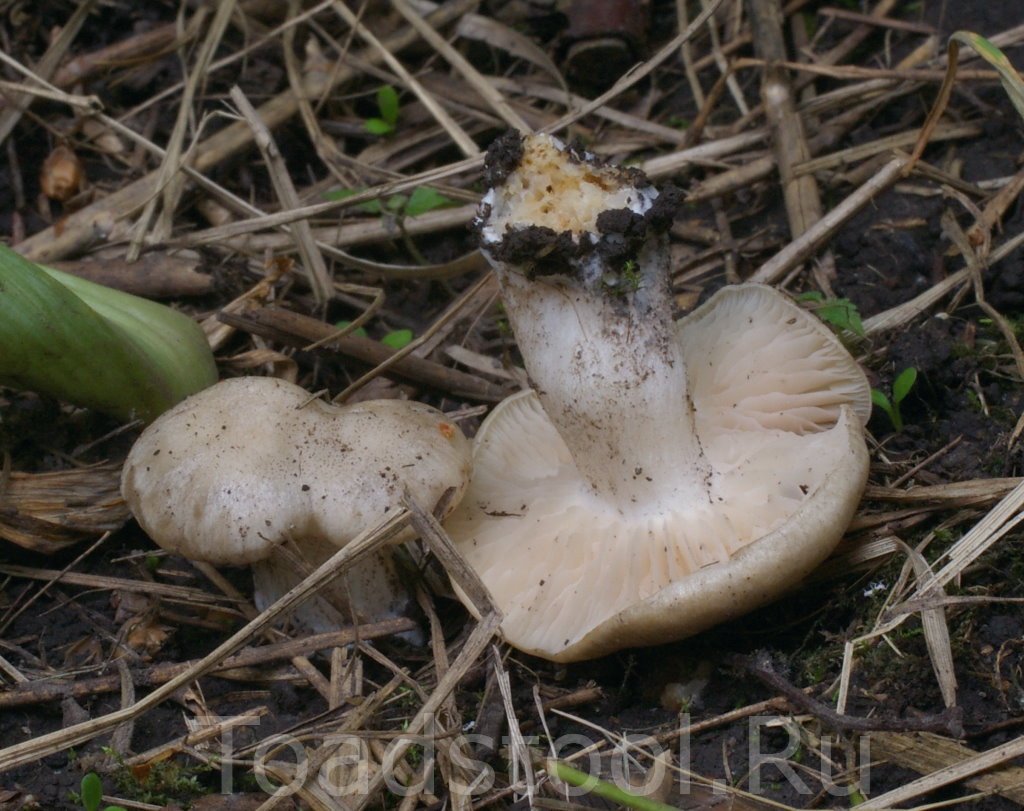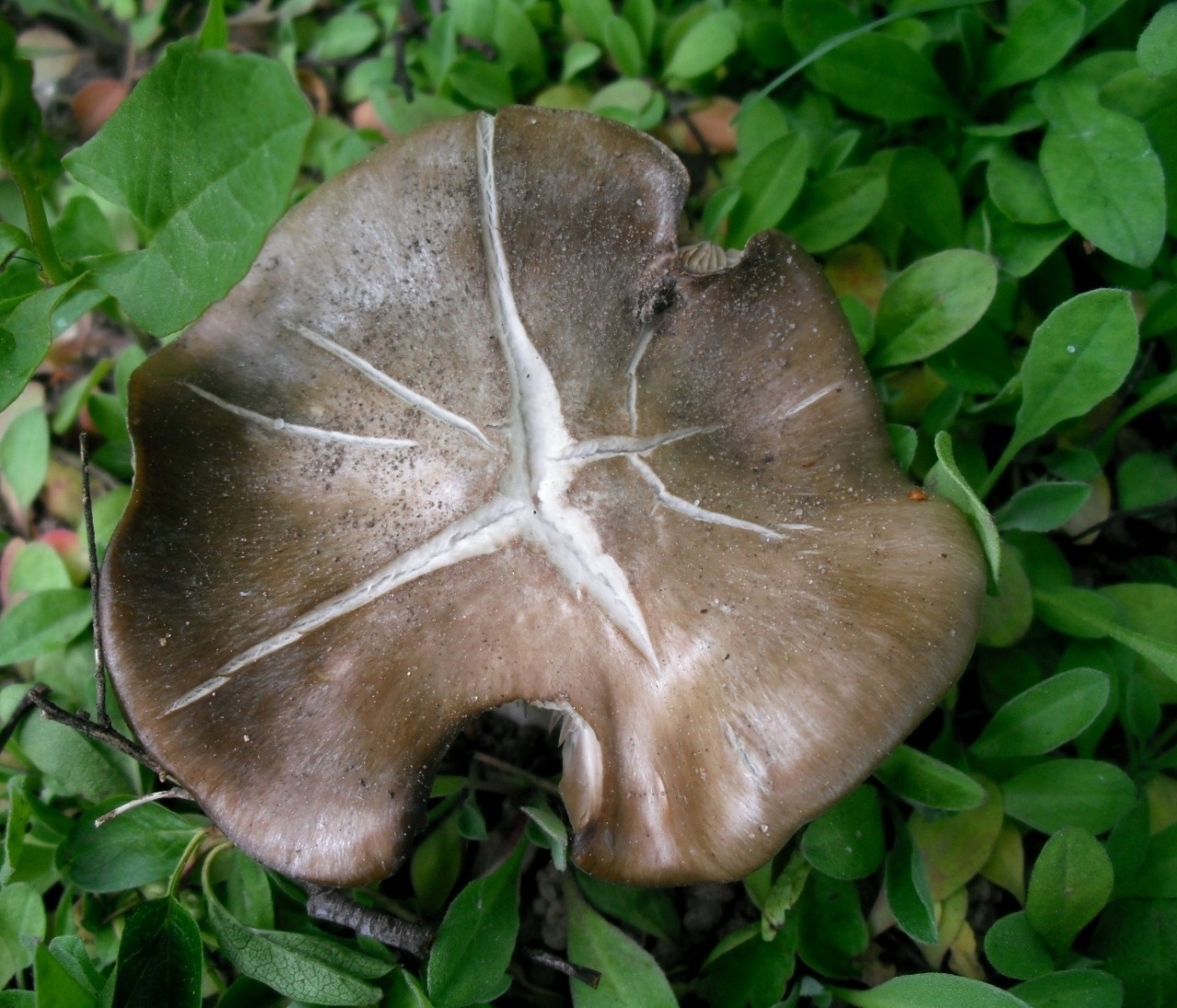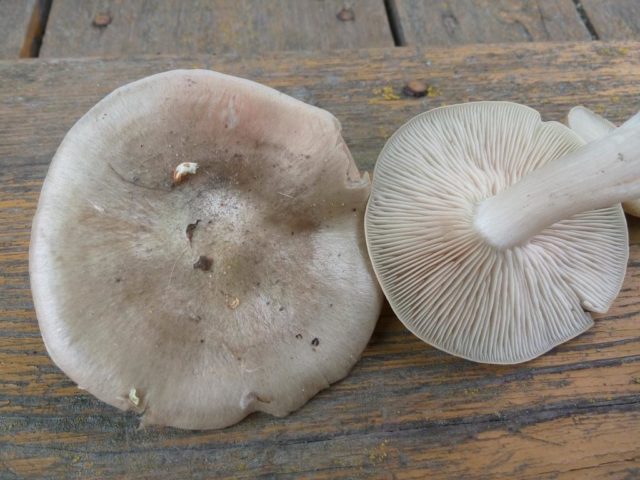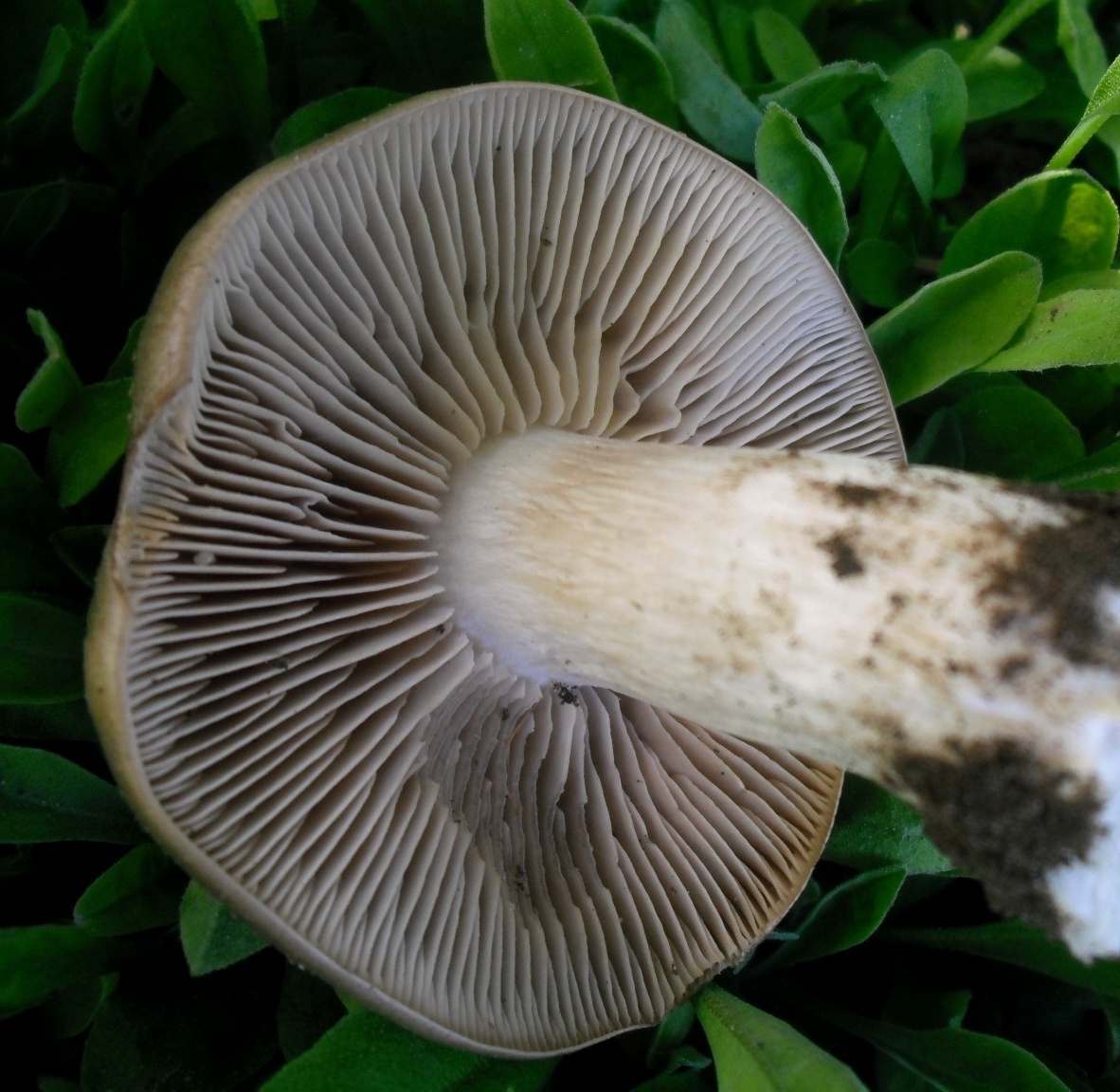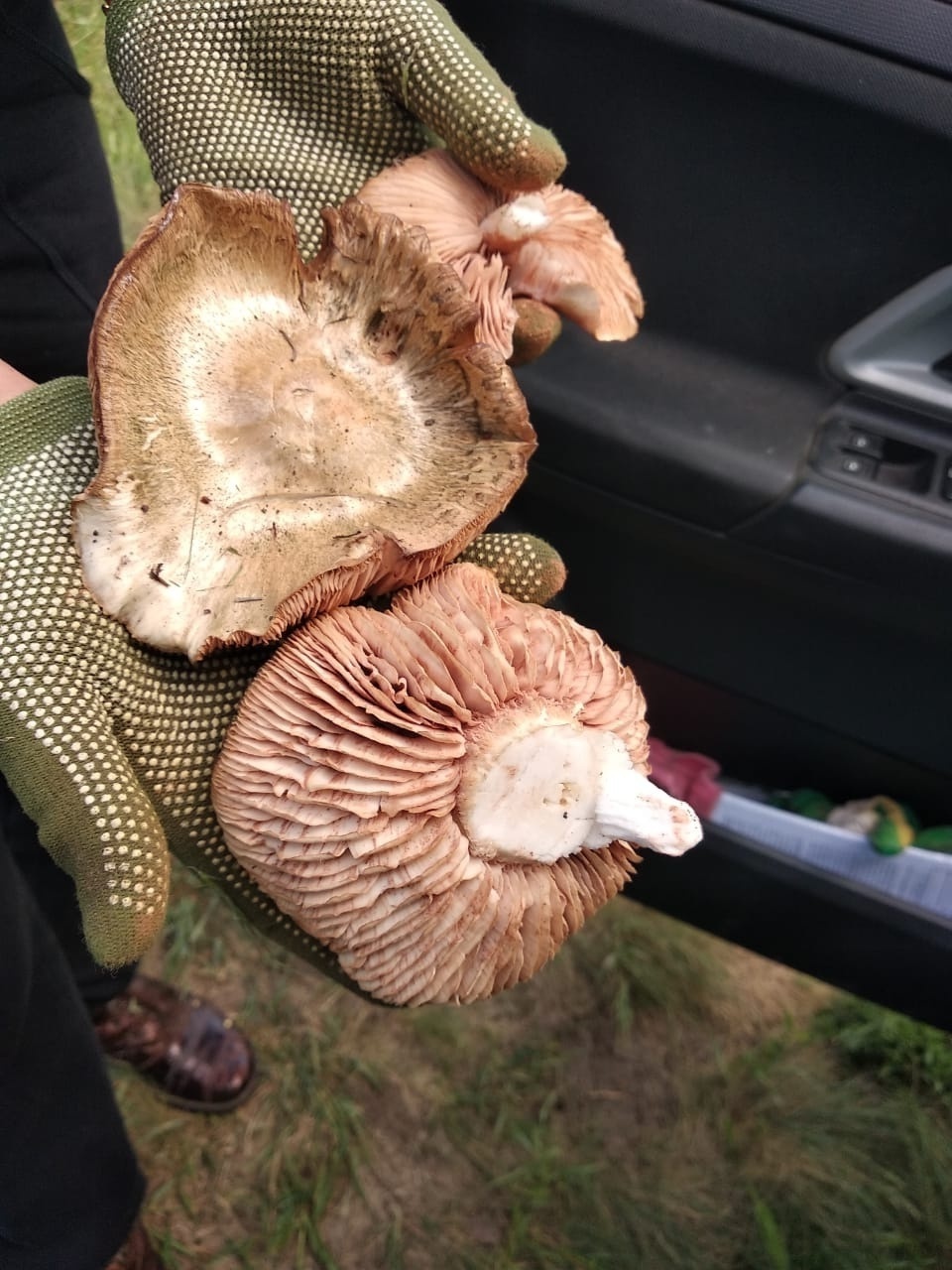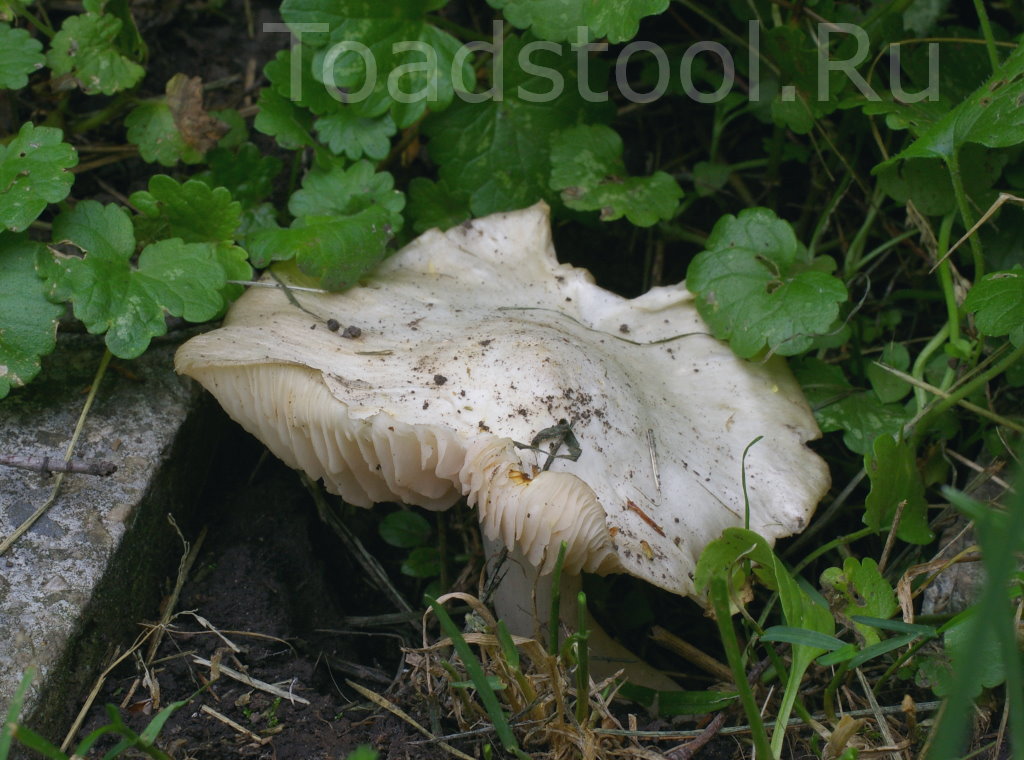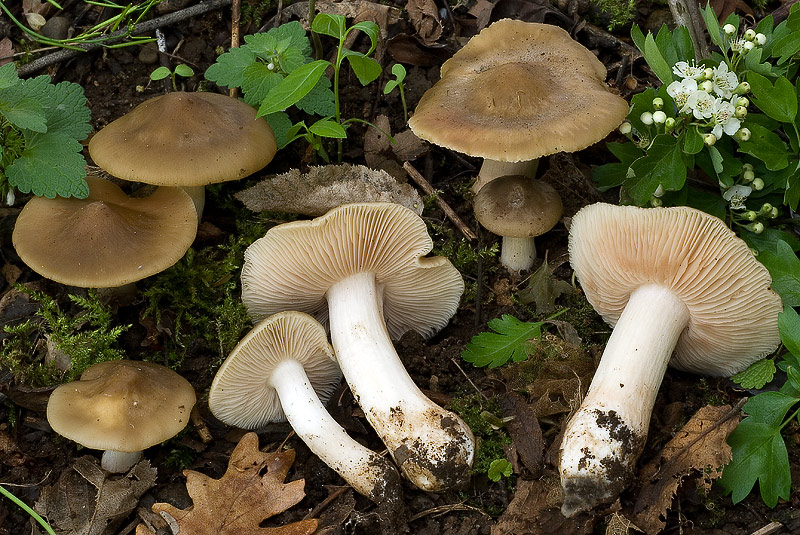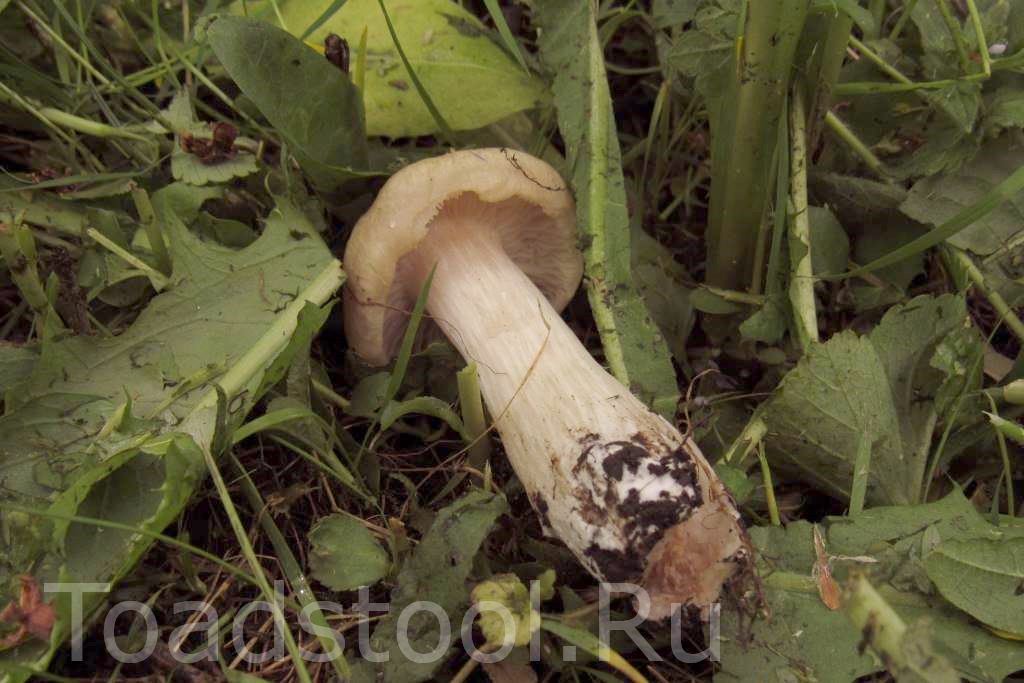Taxonomy, characteristics and description of the structure
According to the systematic nomenclature, Entoloma poisonous belongs to the Entoloma family, the Entoloma genus. Latin name and its synonym: Entoloma sinuatum and Rhodophyllus sinuatus.
This representative is also called:
- Giant rose-colored plate;
- Pink-colored yellowish-gray;
- Entoloma tin;
- Entoloma notched-lamellar.
Hat
The diameter of the cap varies in the range of 5–17 cm, however, representatives with an indicator of 25 cm are often found. Young mushrooms for a long time retain a bell-shaped, in some cases convex shape with tucked edges. With the passage of time and the growth of the mushroom, the cap becomes convex and flat at the ends. In the future, it forms a large tubercle in the center, and its edges become wavy and open. Old mushrooms are characterized by the presence of wrinkles in the middle of the cap. It is smooth to the touch, a little sticky after rain. The color is off-white, yellowish, ashy or brownish-gray.
Hymenophore
The hymenophore is the part of the fungus located under the cap. In entoloma, it is represented by plates. They are very weakly attached to the stem, rarely located. In color, there are both dirty yellow (in most cases in young mushrooms) and pink or even red (in older fruiting bodies). To the edges of the plate are painted in a darker color.
REFERENCE: Most of the representatives of poisonous enthola, which grow in Europe, have no yellow pigment in the hymenophore.
Cut pulp
The pulp is characterized by elasticity and high density, it is white and brownish in color. In the part of the cap, the tone does not change when it breaks. The flesh tastes rancid or has a mealy aroma.
Leg
The fungus is characterized by a central location of the leg, which thickens slightly at the base. It has a cylindrical shape, slightly compressed at the edges. Smooth, silky, dense to the touch. In the part near the cap it has a mealy coating. The leg reaches 10 cm in height, up to 3 cm in width. The color is mainly white, in some cases a gray tint can be traced.
A bit of history
For the first time, they learned about the mushroom in 1788 thanks to the doctor and botanist Pierre Bueyard. A more detailed description was compiled by H.Person (mycologist) at the beginning of the 19th century.
Entoloma poisonous
Poisonous entoloma - lat. Entoloma sinuatum
In a different way, a dangerous mushroom is called Entoloma tin, Rosovoplastinnik gigantic, Rosovoplastinnik poisonous, Entoloma notched-lamellar, or Rosovoplastinnik yellowish-glaucous.
Mushroom cap
Pewter entoloma builds up a giant cap with a diameter of up to 25 cm. The hats of young mushrooms at first have a convex rounded or bell-shaped shape, after which they spread out or remain convex-flat.
The edges of the caps are at first tucked up, as they mature, they are lowered, even or wavy. In the center of the mushroom, a sloping mound is preserved; in old mushrooms, a notch often appears.
The glossy silky skin becomes sticky in wet weather. It is painted gray-ocher or grayish-white, with age turning into a gray-brown shade with an ash tint.
The inside of the hats has a fleshy white flesh that turns brown under the skin and does not change color after damage. The flesh of a young pink-colored plate smells like flour, while old mushrooms exude a rancid odor. It is tasteless or has a bitter taste.
The bottom of the hat is speckled with weakly growing thin plates 8-15 mm wide. Young plates are grayish-yellow in color, while mature ones are pink or reddish with a dark edge.
Giant pink laminae reproduces by angular spores, forming them in pink spore powder.
Stipe
Entoloma poisonous has a powerful cylindrical or clavate leg, bending downward, the diameter of which is 10-35 mm, and the length is 40-150 mm. At a young age, the legs are filled with pulp, which later turns into a spongy mass.
The leg is covered with a smooth silky white skin that turns gray or yellow with time. If you press on it, it will turn slightly brown. The lower part remains smooth, the upper part is covered with a mealy bloom.
Entoloma poisonous (Entoloma sinuatum)
Growing places
Poisonous rose-leaf is a rare mushroom that prefers heavy clay or limestone soil of light deciduous and mixed forests and parks with beech, oak, hornbeam, willow and birch trees. It is found in the South Siberian, North Caucasian and European parts of Russia, as well as in Ukraine.
Single and numerous fruiting occurs at the end of May - beginning of October.
Edibility
The name of the mushroom speaks for itself: Poisonous entoloma is very toxic. Its use causes severe food poisoning, accompanied by fever, vomiting, abdominal pain, etc. If you eat a large number of mushrooms, you can die.
Definitioner
- Basidia (Basidia)
-
Lat. Basidia. A specialized structure of sexual reproduction in fungi, inherent only in Basidiomycetes. Basidia are terminal (end) elements of hyphae of various shapes and sizes, on which spores develop exogenously (outside).
Basidia are diverse in structure and method of attachment to hyphae.
According to the position relative to the axis of the hypha, to which they are attached, three types of basidia are distinguished:
Apical basidia are formed from the terminal cell of the hypha and are located parallel to its axis.
Pleurobasidia are formed from lateral processes and are located perpendicular to the axis of the hypha, which continues to grow and can form new processes with basidia.
Subasidia are formed from a lateral process, turned perpendicular to the axis of the hypha, which, after the formation of one basidium, stops its growth.
Based on morphology:
Holobasidia - unicellular basidia, not divided by septa (see Fig. A, D.).
Phragmobasidia are divided by transverse or vertical septa, usually into four cells (see Fig. B, C).
By type of development:
Heterobasidia consists of two parts - hypobasidia and epibasidia developing from it, with or without partitions (see Fig. C, B) (see Fig. D).
Homobasidia is not divided into hypo- and epibasidia and in all cases is considered holobasidia (Fig. A).
Basidia is the place of karyogamy, meiosis and the formation of basidiospores. Homobasidia, as a rule, is not functionally divided, and meiosis follows karyogamy in it. However, basidia can be divided into probasidia - the site of karyogamy and metabasidia - the site of meiosis. Probasidium is often a dormant spore, for example in rust fungi. In such cases, probazidia grows with metabasidia, in which meiosis occurs and on which basidiospores are formed (see Fig. E).
See Karyogamy, Meiosis, Gifa.
- Pileipellis
-
Lat. Pileipellis, skin - differentiated surface layer of the cap of agaricoid basidiomycetes. The structure of the skin in most cases differs from the inner flesh of the cap and may have a different structure. The structural features of pileipellis are often used as diagnostic features in descriptions of fungi species.
According to their structure, they are divided into four main types: cutis, trichoderma, hymeniderma and epithelium.
See Agaricoid fungi, Basidiomycete, Cutis, Trichoderma, Gimeniderm, Epithelium.
- Trichoderma (Trichoderma)
-
The type of cap skin, usually consists of straight, septate elements located more or less perpendicular to the surface and laid both at the same and at different levels; the ends of the hyphae can be morphologically modified and represent dermatocystids. The surface of the cap is velvety to almost felt.
Lat. Trichoderm.
Trichoderma, in turn, is subdivided into intertwined trichoderma and irregular trichoderma.
Intertwined trichoderm (Intricate trichoderm) - trichoderm, consisting of intertwined hyphae, located not parallel to each other and forming a tomentose pubescence.
Irregular trichoderm - Trichoderma, consisting of irregularly branching hyphae.
See Dermatotsistida, Hypha, Septa.
- Cutis
-
The type of cap skin, consists of creeping non-gelatinized hyphae located parallel to the surface. The surface of the cap looks smooth.
Lat. Cutis.
See Gifa.
Poisoning signs and first aid
If it happened that by mistake a poisonous entoloma got into the basket with mushrooms, then you can detect signs of poisoning half an hour after eating it. It is easy to recognize the condition by the following signs:
- the appearance of a migraine that does not go away;
- sharp dizziness;
- attacks of nausea and vomiting;
- stomach upset;
- flatulence;
- weakness.
If the above symptoms appear, you need to seek medical help as soon as possible. If this is not possible, then the necessary measures should be taken to remove the toxic fungus from the body. First aid:
- If the poisoning manifests itself without indigestion, then you should take a teaspoon of petroleum jelly and any vegetable oil to provoke diarrhea.
- If an upset stomach has already manifested itself, then it is worth drinking a large amount of warm water and taking activated charcoal according to the instructions.
- If there is a chill, then you need to observe bed rest, wrapped in a warm blanket.
First aid provided on time can save the life of the victim. But it is imperative to go to a medical facility, because in some cases it is required to carry out a blood transfusion or put droppers with physical. solution.
Entoloma light brown (Entoloma sepium)
Entoloma light brown - lat. Entoloma sepium
In a different way, this mushroom is called Ternovik, Entoloma sepium, Poddyuchnik or Pale brown Entoloma.
Mushroom cap
Ternovik builds on a rather large hat with a diameter of 30-150 mm. Young hats are made in the form of a flat cone, more mature hats are transformed into wide cones or spread out. In the middle, a non-steep, often flattened mound is formed.
In dry weather, the skin on a fine-stapled hat remains silky - dry and light, in wet weather it becomes sticky and darker. It is colored in yellowish, gray-brown and brownish-yellow tones.
The hats are filled with a tasteless, tight, whitish pulp that exudes a pleasant aroma of fresh flour.
The bottoms of the hats are covered with broad, descending mid-range plates. Young Entoloma sepium has white plates, an adult mushroom is creamy pink, overripe specimens are pink-brown.
Pale brown entoloma reproduces by rounded-angular reddish spores contained in pink spore powder.
Stipe
The cylindrical fibrous stalk of Podoruchnik reaches 8-20 mm in thickness and 30-150 mm in length, and can be bent. The legs of young mushrooms are filled with pulp, which disappears as they mature.
The smooth surface of the legs is white or cream-white.
Entoloma light brown - lat. Entoloma sepium
Growing places
Entoloma light brown prefers mountain slopes, ravines, gullies, and is found under park and garden plantings. It grows abundantly where plum, cherry-plum, apricot, hawthorn and thorn trees and shrubs grow. The mushroom is harvested on Kazakh soil; it also inhabits the Western Tien Shan.
Fruiting of Entoloma sepium occurs in scattered clusters from the last days of April to the end of June. In warmer regions, the mushroom begins to bear fruit from mid-April.
Edibility
Pale brown entoloma belongs to conditionally edible mushrooms: it can be fried, used as a side dish, pickled and salted.The main thing is to boil the mushrooms for 20 minutes in salted water before cooking, and drain the broth.
According to gourmets, the most delicious Entoloma sepium comes from pickling.
Interesting facts about the dangerous mushroom
- Despite the fact that most poisonous mushrooms are not too dangerous even when eaten, poisonous entoloma can be fatal. It is enough to eat a few mushrooms for a deadly amount of poison to enter the body.
- Most often, poisonous entoloma is found near beech, oak, hornbeam, sometimes willow and birch. This is due to the fact that mycorrhiza forms in the tree and fungus.
- While developing, poisonous entoloma changes its taste from mealy to bitter and unpleasant.
- The younger the mushroom, the denser the leg. In older fruiting bodies, it takes the form of a sponge.
- Most of the poison leaves the fruiting body if the mushroom is boiled, changing the water twice, or dried.
Knowing what a rose-colored plate looks like, you can not be afraid to pick mushrooms in the forest. In order not to face the negative consequences of eating poisonous entoloma, you should first boil the mushrooms twice or use them in dried form.
Poisonous entoloma (rose leaf), its differences from other mushrooms
At the time of the mushroom "hunt" sometimes there are cases of poisoning with the gifts of the forest. The fact is that some poisonous mushrooms are very similar to edible ones. These include the poisonous entoloma - the largest representative of its family. Its fibers contain a strong poison that can be fatal without proper help.
The appearance of the mushroom
The poisonous lamellar mushroom entoloma, a description of which was first given by H. Person in 1801, is rather large. Usually the cap reaches a diameter of 6-16 cm, in rare cases - 25 cm.
At an early stage of development, the color of the cap ranges from off-white to gray with a touch of ocher. By old age, the color changes towards darker shades and becomes gray-brown. The cap is smooth to the touch; large specimens have small folds in its center.
When wet, the surface of the cap becomes sticky and shiny; when it dries, the shine remains.
In youth, the cap has a hemispherical shape, which, with age, becomes a bell with the edge wrapped around the leg. In old mushrooms, a notch appears on the cap in the center.
Red trellis mushroom: edible or not
The distinctive features of poisonous entoloma include the following:
- the flesh does not change color at the break;
- rare and wide plates;
- the smell of a young mushroom is mealy, with age it becomes rancid.
Distribution and places of growth
Poisonous entoloma, or poisonous rose leaf, is a relatively thermophilic mushroom. Distributed in the southern regions of Russia, comes across in the Caucasus, is well known to the inhabitants of Ukraine and the Republic of Belarus. This mushroom is rarely found in Karelia and the Murmansk region. In Western Europe, it practically does not occur - it is very rarely found in Austria and the mountainous regions of France.
He loves the neighborhood of hornbeam, beech, oak, sometimes it can be found near a willow or birch. Grows, as a rule, in small groups of 2-4 pieces. Favorite growing places are in the shade, under trees, in beams, on swampy soils with a high lime content.
Similar species
There are many edible mushrooms that are similar in appearance to the poisonous rose leaf, which poses a danger to novice mushroom pickers. Most often, fans of "mushroom hunting" confuse entoloma with the following mushrooms:
- pendant - the color is almost identical, the difference is in the plates descending to the leg;
- smoky ryadovka - differs in smaller plates, the color of which is noticeably lighter;
- pigeon ryadovka - differs in a hat, on which colored spots are noticeable, and flesh turning pink on the cut;
- smoky talker - it has a peculiar floral or putrid smell, the plates are narrower and lighter;
- common champignon - is distinguished by the presence of a ring on the leg and dark-colored plates;
- rose-leaf garden - an edible mushroom that grows in gardens and meadows, differs in that its cap has a hygrophilous property (swells when wet).
Edible and Poisonous Species of the Yellow Spiderweb Mushroom
Entoloma poisoning and treatment
When eating even a small piece of this poisonous mushroom, irritation of the gastrointestinal mucosa and intoxication of the body occurs with the following symptoms: severe migraine, vomiting, pain and cramps in the abdomen, diarrhea, dizziness. Signs of poisoning appear within 30-120 minutes.
Inpatient treatment usually lasts no more than 3-4 days. It is carried out permanently in the clinic with the intake of toxin-removing drugs. Glucose and saline are injected intravenously through a dropper.
First aid for poisoning before the arrival of an ambulance consists in washing the stomach, taking sorbents and laxatives.
If chills are observed, the victim should be wrapped in a blanket, blanket or additionally put on warm clothes.
Calling an ambulance is mandatory, you cannot try to cure the poisoning yourself. It is advisable to collect the remains of the mushrooms for transfer for examination to determine the type and degree of toxicity. In severe cases, a blood transfusion is required to save lives after entoloma poisoning, which can only be done in a clinical setting.
After providing first aid and carrying out the entire complex of medical procedures, a poisoned entoloma poisonous may for some time (1-2 weeks) experience deviations from the norm in the state of the body: frequent migraines, increased irritability, severe thirst and indigestion. In this case, it is recommended to take as much fluids as possible to remove toxins from the body.
Galerina edged mushroom: description and differences from honey agarics

